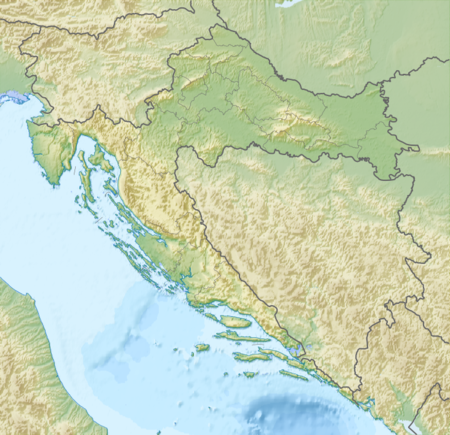
Back قائمة مدن وبلدات كرواتيا Arabic Widava ke Xrvatska AVK Xorvatiya şəhərləri Azerbaijani Gmoana in Krowozien BAR Сьпіс гарадоў Харватыі BE-X-OLD Списък на градовете в Хърватия Bulgarian Daptar kuta di Kroasia BJN Spisak gradova u Hrvatskoj BS Llista de ciutats de Croàcia Catalan Seznam měst v Chorvatsku Czech
An urbanized area in Croatia can gain the status of grad (which can be translated as town or city as there is no distinction between the two terms in Croatian) if it meets one of the following requirements:
- is the center of a county (županija), or
- has more than 10,000 residents, or
- is defined by an exception (where the necessary historical, economic or geographic reasons exist)
A city (town) represents an urban, historical, natural, economic and social whole. The suburbs comprising an economic and social whole with the city, connected with it by daily migration movements and daily needs of the population of local significance, may also be included into the composition of a city as unit of local self-government.[1]
Grad (city/town) is the local administrative equivalent of općina (translated as "municipality"), with the only distinction being that the former usually comprise urban areas whereas the latter commonly consist of a group of villages. Both municipalities and city/towns often comprise more than one settlement, as the administrative territory of a grad may include suburban villages or hamlets near the city/town in question. Settlements (naselja) are the third-level spatial units of Croatia,[2][3] and the smallest unit for which the decennial census data are published by the Croatian Bureau of Statistics but are not administrative entities, i.e. they are governed by the municipal or city/town council of the local administrative unit they belong to.
Croatian cities are administratively subdivided into "city districts" (gradski kotari/gradske četvrti) and/or "local committees" (mjesni odbori) with elected councils. The City of Zagreb, as the capital, not being part of any county, is subdivided into both city districts and local committees.[4]
- In December 1992 there were 70 cities and towns and 419 municipalities in Croatia organized into 20 counties (plus the city of Zagreb which is both a city and a county).[5]
- In 2001 there were 122 cities and towns (excluding Zagreb) and 423 municipalities. This was the territorial division used for the 2001 census.[5]
- In 2006 the latest revision was made, which listed a total of 127 cities and towns and 429 municipalities in Croatia. This division was used for the latest 2011 census.[6]
- In 2013 the municipality of Popovača was upgraded to town, bringing the total to 128 cities and towns and 428 municipalities.[7]
According to the Constitution, the city of Zagreb, as the capital of Croatia, has a special status. As such, Zagreb performs self-governing public affairs of both city and county.[8]
- ^ "Zakon o lokalnoj i područnoj (regionalnoj) samoupravi (pročišćeni tekst)" [Local and Regional Self-Government Act (consolidated text)]. Narodne novine (in Croatian). No. 19/2013. 18 February 2013. Retrieved 5 October 2016.
- ^ Register of spatial units of the State Geodetic Administration of the Republic of Croatia. Wikidata Q119585703.
- ^ "Zakon o područjima županija, gradova i općina u Republici Hrvatskoj". Narodne novine (in Croatian). Retrieved 2023-10-02.
- ^ "Local self - government". City of Zagreb Official Website. Retrieved August 25, 2020.
- ^ a b "Explanation on changes of the territorial constitution of the Republic of Croatia from 1991 to 2001". Croatian Bureau of Statistics. Retrieved 13 January 2011.
- ^ "Census of Population, Households and Dwellings 2011 - Notes on Methodology". Croatian Bureau of Statistics. Retrieved 27 January 2014.
- ^ "Popovača dobila status grada". Poslovni dnevnik (in Croatian). 12 April 2013. Retrieved 27 January 2014.
- ^ The Constitution of the Republic of Croatia (consolidated text) - Croatian Parliament Archived 2015-11-02 at the Wayback Machine.Retrieved 5 October 2016.
© MMXXIII Rich X Search. We shall prevail. All rights reserved. Rich X Search
